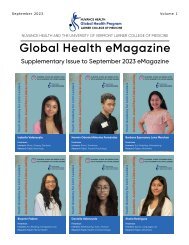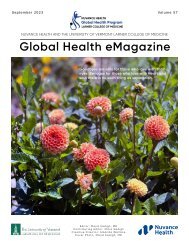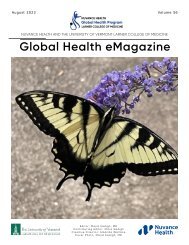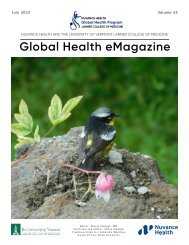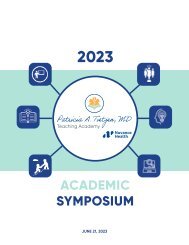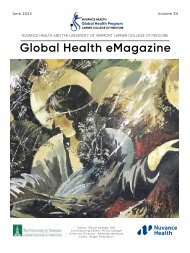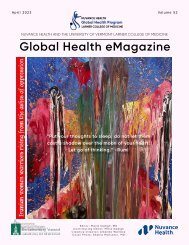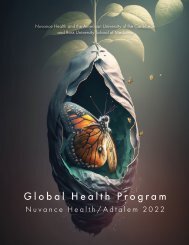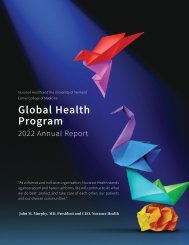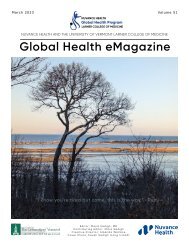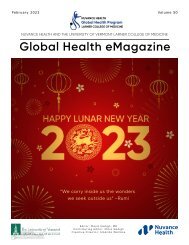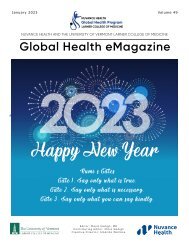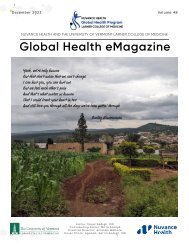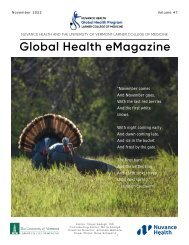climbforacause2019_rev
Create successful ePaper yourself
Turn your PDF publications into a flip-book with our unique Google optimized e-Paper software.
Climb for a Cause<br />
2019
Photography by Katrin, Mitra and Majid Sadigh and Aron Legler<br />
Editors; Katrin and Mitra Sadigh<br />
Creative Director; Amanda Wallace<br />
2
3
4
Day 0<br />
The altitude of Moshi is 950 meters.<br />
We spent the day before our hike<br />
driving up old Mosh road with our<br />
driver and one of our guides. We<br />
visited sites related to the time of<br />
German colonization in the mid to<br />
late 1800s, including churches and<br />
old stone plaques marking gravesites.<br />
We also learned about Mangi Meli,<br />
the leader of the north of what is now<br />
Tanzania, for whom a memorial lies at<br />
the foot of the tree from which he was<br />
executed in 1900 in front of his people<br />
for his role in the rebellion against the<br />
German colonial rule.<br />
We walked to the gate of Marangu<br />
Route, and made our way slowly up<br />
the road, which winds its through<br />
corn fields lined with banana trees.<br />
Small communities embedded in<br />
the hills overlook the verdant valley<br />
below. We met children and women<br />
carrying loads of wood, even an older<br />
villager in his studio, who showed us<br />
his instruments and hand-carved<br />
wooden and metal artwork. Mitra<br />
and Katrin practiced their hiking<br />
pole skills, while Majid photographed<br />
the eucalyptus trees and colorful<br />
evocative flowers. We reached an<br />
altitude of roughly 1900 meters before<br />
making our way back to the hotel to<br />
prepare for Day 1.<br />
5
Day 1<br />
Our group shared a leisurely breakfast at the<br />
hotel while we awaited our guide and team<br />
to begin the day. A large vehicle arrived filled<br />
with our gear (tents, sleeping mats, food,<br />
portable toilet) and all of the members of our<br />
team: 3 guides, 24 porters and 1 cook.<br />
We arrived at Machame Gate with an altitude<br />
of 1800 meters. While awaiting for our team<br />
to arrange for our park permit, we relaxed in<br />
an open verandah while observing monkeys<br />
fly off branches, preen their young and steal<br />
banana peels. We enjoyed a delicious lunch<br />
of onion soup and spaghetti. The process<br />
of park registration is an involved one. Each<br />
porter can carry no more than 20 kilograms.<br />
Bags are weighed and contents adjusted<br />
accordingly. It was determined that we<br />
needed three additional porters, and one of<br />
our guides was tasked with the difficult job of<br />
selecting them of the large group of hopefuls<br />
who had waited since the early morning to be<br />
granted the highly coveted work of a porter.<br />
While we were the last group to begin the<br />
hike, we enjoyed an impromptu yoga class led<br />
by Mitra, and a trail all to ourselves.<br />
We spent five hours walking slowly, step by<br />
step, deep in conversation with one another,<br />
through the rainforest filled with trees hanging<br />
thick with moss, dense thickets of fern, and all<br />
manner of trees. Occasionally we heard the<br />
bay of monkeys nearby.<br />
We reached Machame Camp at 2835 meters<br />
shortly after nightfall-- over 1000 meters of<br />
ascent in 5 hours. The camp has roughly 220<br />
hikers and over 400 porters today. Our team<br />
had already set up our tents and prepared<br />
dinner. We gathered together in the mess hall,<br />
and warmed up with a hot beverage and a<br />
fish, vegetable and pototo dinner. Two of our<br />
6
guides then came in to discuss the next day's<br />
plans, and to notate our heart rate and oxygen<br />
saturation, and our fluid intake. Everyone is<br />
feeling well, and excited about our first day's<br />
hike deep in the rainforest of Kilimanjaro.<br />
We head to Shira Camp in the morning. Now it<br />
is time for sleep.<br />
7
8
9
10
11
12
Day 2<br />
We hiked from Machame camp to Shira<br />
cave, a total of 1000 meters altitude<br />
gain. It was a beautiful, slow ascent with<br />
temperatures in the 60s and intermittently<br />
sunny. After the eight-hour hike, we were<br />
happy to see our orange tents in the<br />
distance. After settling into the camp and<br />
registering at the site, we took a short walk<br />
to the caves, where porters used to cook<br />
and camp. We were told that use of the<br />
caves was banned in 1995 as many porters<br />
were becoming sick from the fumes and<br />
cold. We returned to the camp for the<br />
welcome ceremony. Our entire group<br />
gathered in a half circle, singing and<br />
dancing their songs. Majid joined on their<br />
side, and Mitra danced in the middle. At<br />
the end, each member of our team stated<br />
his name and role, and then we introduced<br />
ourselves in turn. During the check in after<br />
dinner, our guide Washingtone described<br />
the history of the place-- the site where<br />
two local tribes, the Masaii and the<br />
Chagga, came together to fight for their<br />
cattle.<br />
13
14
15
16
17
18
19
20
21
22
Day 3<br />
Today we began at Shira cave (3850 m)<br />
to Lava Tower (4600 m) to Baranco Camp<br />
(3900 m). We started the hike expecting<br />
similar weather as the p<strong>rev</strong>ious day, but<br />
were blasted by an unfailing wind that<br />
blew across desolate-appearing land<br />
as the clouds and the Kilimanjaro ravens<br />
circled above us, never straying too far<br />
away. Our hearts warmed to the hot lunch<br />
awaiting us atop the wind-swept Lava<br />
Tower after the difficult four-hour hike.<br />
The cold had crept even deeper into our<br />
bones as we prepared for the final 2-3 hour<br />
hike. But the sun peaked out occasionally<br />
during our descent from Lava Tower, and<br />
the landscape opened up to the Arrow<br />
Glacier on our left. We strode through<br />
towering Ground Sel plants, feeling lighter,<br />
braver and happier.<br />
23
24
25
26
27
28
29
30
Day 4<br />
We started at Baranco Camp, where we<br />
relished the experience of waking up to a<br />
windless morning. The sun came up over<br />
Arrow Glacier, a quiet yet heavy presence<br />
behind us. We then started our climb up<br />
Baranco Wall with an average 45% grade,<br />
awed by the meandering trail carved into<br />
the mountain face. At no other place was<br />
the porters' responsibility so visible, so<br />
palpable-- each carrying 20 kg on his<br />
head or neck, a backpack and additional<br />
items stringed on. There we were,<br />
scrambling, scurrying, trying to balance<br />
ourselves on all kinds of rock edges. We<br />
were entirely in the clouds, looking down<br />
from various ledges, in the direction from<br />
which we came, seeing nothing but rapidly<br />
moving clouds. The weather shifted swiftly,<br />
unexpectedly, temperamental and bizarre,<br />
forcing us to put layers on and off and on<br />
again, and yet framing the landscape in<br />
alternating austere and rich tones. We<br />
crossed three zones in an odd order today,<br />
from moorland at Baranco Camp to alpine<br />
desert at Baranco Wall, to the heather zone<br />
at the Karanga River, finishing once again<br />
at alpine at Karanga Camp. It was unusual,<br />
thrilling, to find the verdant world around<br />
the river caught between alpine zones. On<br />
arrival to camp, we found our tents up and<br />
hot water ready. The rain came out of the<br />
blue, and with it the numbing cold, as we<br />
played cards and shared our thoughts on<br />
this mountain.<br />
31
32
33
34
35
Day 5<br />
It is 12:45 pm on Thursday, August 1st.<br />
We just arrived to the final camp. On<br />
our way up we passed through the<br />
alpine zone and entered the lifeless<br />
zone where lichens are one of the<br />
few signs of life. We began the day<br />
with brilliant sun and everchanging<br />
landscape. On our way up, we ran<br />
into a 29-year-old man climbing<br />
this mountain in memory of his two<br />
friends, suffering pulmonary edema.<br />
We encouraged him to descend<br />
as soon as possible. He was very<br />
ill and crying tears of sadness, as<br />
he considered his illness a failure.<br />
Clouds soon rolled in and enveloped<br />
all by the time we reached Barafu.<br />
36
37
38
39
Day 6<br />
We woke up to the bitter cold of 11 PM,<br />
some of us refreshed after a 2-3 hour nap,<br />
others tired after tossing and turning in our<br />
constrained positions in our sleeping bags.<br />
The plan was to get our gear ready, drink a<br />
hot beverage and juice with biscuits, and<br />
then head up 6 hours (4.3 km/2.67 miles)<br />
to Stella Point from our Barafu Camp at<br />
4600 meters (150912 feet) From there we<br />
would need to put in another 1.5 hours to<br />
scale the 0.7 km (0.4 miles) to Uhuru Peak,<br />
our final destination.<br />
Washingtone's parting words before we left<br />
for our tents: "The problem here is altitude. If<br />
you're not feeling great, tell us now. We'll take<br />
you down to Mweka, a camp in the rainforest.<br />
There is plenty of oxygen in rainforest, you<br />
will feel at home. Otherwise prepare yourself<br />
for a 15 hour day. Don't push yourself."<br />
It was not easy getting up, despite the<br />
anticipation of the final summit. Our sleeping<br />
bags coccooned us in a safe envelope<br />
of warmth-- unzipping ourselves into the<br />
night was almost more than we could bear.<br />
But we did, and completed the layering of<br />
shirts, jackets, fleece, thermals, ski pants,<br />
socks, hats, balaclava. Next the addition of<br />
electrolyte tablets to our CamelBaks and<br />
water bottles. Then the securing of head<br />
lamps and gators, the resizing of our hiking<br />
poles. Our three guides looked us over one<br />
at a time, fixing and repositioning before the<br />
final approval. And then we were ready with<br />
our guides and three summit porters.<br />
At the onset, we could look up at the<br />
mountain face and see a trail of headlamps<br />
lighting the way by those who had started<br />
before us. It was daunting to see how far we<br />
40
41
42
43
had to go. During brief breaks to catch our<br />
breaths in the thin air, our heads would roll<br />
back and we would lose our breaths again by<br />
the wonder of the stars dotting the sky with<br />
their luminosity. But it was hard going--even<br />
the smallest action (opening the wrapper<br />
around a hard candy, unzipping a pocket,<br />
re-positioning a strap) felt like a heavy task<br />
and left us even more breathless.<br />
Our guides never left our side, suddenly<br />
appearing beside us, asking how we were.<br />
And so we trod on, each finding an internal<br />
source of strength based on our own<br />
motivation at the start of this climb. At one<br />
point, a Masaii group of guides and porters<br />
began to sing, their voices uplifting us,<br />
blowing wind into our sails.<br />
Minute after minute, we walked, crawled,<br />
moved further up the mountain. Mitra was<br />
struck with migraine, and she and Majid<br />
44
45
46
slowed their pace, with a guide and two porters breaking off with them. The sun rose in layers<br />
of color, illuminating the frozen lakes and river at the foot of Arrow Glacier, once so imposing<br />
but now dwarfed in size, though not majesty, from our towering heights.<br />
One last switchback and we were finally at Stella Point, gazing deep into the crater, and the<br />
elated faces of friends and guides. The next 0.7 km (0.4 miles) felt impossible, but words of<br />
encouragement from strangers walking back down propelled us forward in a daze that had<br />
begun with the sunrise and was only elevated by the sight of the 22,000-year-old glaciers.<br />
Some shouted with joy, others wept out of gratitude and awe, but all were bound heart and<br />
soul to the mountain that had taken and yet bared so much in return.<br />
Soon after, still atop the mountain, we were united again as a team with Mitra, Majid and<br />
their group. The descent down felt like sand skiing, until we were struck with snowfall and<br />
whipping winds (which became heavy rains for Mitra and Majid) by the time we reached our<br />
camp. Exhausted and sullen after an anticlimactic finish (we still had five hours to go before<br />
we could truly rest), and somehow feeling the drag of altitude, we reluctantly repacked our<br />
bags and took off for lower ground.<br />
We passed into the heather zone and finally the rain forest, where our tents were pitched,<br />
dinner ready and our hearts (like our lungs) full.<br />
47
48
49
50
51
52
Day 7<br />
On our final day, we woke up feeling<br />
stronger than ever before after blissful<br />
sleep surrounded by the sounds of the<br />
rain forest.<br />
Our 4-5 hour slow descent on muddy trails<br />
brought us to the foot of colobus monkey<br />
communities, old twisted trees, and a<br />
thousand shades of green. We found time to<br />
ask questions of our guides, to understand<br />
their experiences on Kilimanjaro.<br />
We arrived at the Mweka Gate, and shared<br />
lunch at an artists' studio.<br />
During the Appreciation/ Tipping Ceremony,<br />
we sang and danced to thank our porters,<br />
guides, cook who had pulled us up to<br />
summit.<br />
And then we said goodbye, the mountain<br />
still a force connecting us.<br />
53
54
55
56
57
58
59
60
Interview with Majid Sadigh, MD<br />
Climb for a Cause 2019<br />
What inspired your first hike of Mt. Kilimanjaro and what inspired the latest?<br />
My first climb up Kilimanjaro in 2002 was driven by a desire to experience walking into thin air,<br />
seeing the 22,000-year-old glaciers, and appreciating the diversity of life and ecosystems<br />
on the roof of Africa. Though the inspiration behind my two most recent climbs has been to<br />
gather money and build awareness about global health issues - with last year’s hike raising<br />
funds for a microbiology lab in rural Uganda, and this year’s for the global health training of<br />
nurses - my time on the mountain is deeply personal. The mountain puts me through trials<br />
of bitter cold and restless sleep, pushing me to my last ounce of strength, but it also builds<br />
me up. Whatever internal struggles surface, I am able to construct a sense of purpose and<br />
preserve it with layers of courage that allow it to survive when I return to reality and away<br />
from this life force.<br />
Having grown up in mountainous Iran, mountains have always felt like home for me, and<br />
it had long been a dream of mine to share this love with my children. This dream first<br />
manifested over ten years ago when the three of us, along with one of my sons, Keyvan,<br />
traveled to Mt. Kenya together. Though I ended up descending on summit day with Mitra<br />
when she developed altitude sickness symptoms, the time we all shared together was<br />
incredibly meaningful. Given that the best predictor of mountain sickness is a history of<br />
having the condition, I was concerned about Mitra making this climb. Meanwhile, my elder<br />
daughter Katrin has Raynaud’s disease, a condition in which distal arterioles constrict in<br />
the cold. In unfortunate cases, the tips of fingers, toes, nose, and ears may be lost. In light<br />
of these concerns, I could not stay home as my daughters ventured on this undertaking.<br />
Thus, another motivation was the need to be beside them both to care for them and share<br />
Kilimanjaro’s beauty and lessons.<br />
Among the many teachings the mountain gifts us with, and a motivation for each climb,<br />
is the reminder that health is a privilege. The last ascent starts at Barafu camp around<br />
midnight, and involves fifteen hours of continuous challenge up the steep climb to Uhuru<br />
peak first through the dark and then under the embrace of sunrise. During last year’s<br />
climb in particular, I struggled through this stretch with chest tightness and pain, severe<br />
exhaustion, shortness of breath, and headache, as well as body and joint pain. Undergoing<br />
this wide spectrum of discomfort reminded me of the discomfort of patients, be they in the<br />
hospital, clinic, or emergency room. I returned home with heightened empathy and care<br />
toward patient’s conditions and complaints, and a greater motivation to help ease their<br />
discomforts.<br />
Stepping into the dead zone where everything is barren feels like setting foot on the<br />
moon. Surrounded by rocks, dust, and lava without any sign of life, the body struggles as<br />
the boundary fragile boundary between health and illness is <strong>rev</strong>ealed. Furthermore, the<br />
transition from the bottom of the mountain that is rife with a miraculous diversity of life<br />
61
up into thin air where life barely subsists reminds us of the close tie between life and oxygen<br />
supply. It reminds us of the care we owe Mother Nature, and the reality that we rely on other<br />
life to survive. I leave the mountain with a renewed commitment to the basic principle of the<br />
One Health movement: that the health of the environment, other life forms, and human beings<br />
are inextricable.<br />
Finally, the inspiration for every ascent that carries me through to the next climb is the spiritual<br />
experience of, along with each step, looking up at the line of headlamps lighting the path like<br />
candles to a sacred temple; the tacit solidarity of each individual blending into the group as<br />
it makes the pilgrimage to the peak as one unified organism.<br />
What was special about this hike?<br />
Several elements made this hike special. First, our group was comprised of an interesting<br />
amalgamation of people-- physicians (infectious disease, emergency medicine, cardiology,<br />
anesthesiology), a horticulturist, a computer programmer, and a global health writer and<br />
researcher. Our main guide was named Washingtone, a man of great intellect and humanism<br />
who had led me up and down Mt. Kilimanjaro in the past, and with whom I had specifically<br />
requested Katrin to arrange our trip. Bringing together Washingtone's group of guides and<br />
porters together with our group, especially some of the conversations we shared around their<br />
lives and dreams, was one of the most memorable aspects of the trip.<br />
Second, it was truly special that me and my daughters were able to spend quality time<br />
together, and during such a momentous experience. I learned of Mitra’s resilience. Within the<br />
first half hour of our final ascent, she threw herself to the side with dizziness, nausea, and the<br />
start of what would be a severe migraine. As I mentioned before, the greatest predictor of<br />
mountain sickness is prior mountain sickness, which means Mitra was at risk of experiencing it<br />
again. She started this climb knowing she might not summit, as she could not years ago. When<br />
I recommended that she descend, she insisted that she wanted to continue. I was concerned<br />
the entire ascent, keeping a close eye on her to monitor her health. It is difficult to differentiate<br />
between when a migraine, nausea, and vomiting will lead to with severe mountain sickness<br />
and when the symptoms can be tolerated without risk. Despite her struggles and a bout of<br />
vomiting close to the summit, she ascended with the words “Bodily discomfort is temporary.<br />
In the near future, I’ll be in a tent with a cup of tea in hand without a migraine, but right now<br />
I am embraced by this majestic mountain, fully enjoying it.” Kilimanjaro’s beauty was more<br />
encouraging than the pain was discouraging.<br />
Third, we connected with a young man who was breathing heavily and coughing on the ascent<br />
just near base camp. Though we had seen him every day on the trail looking exhausted but<br />
well enough, he was noticeably ill this time. We stopped to ask him some questions and do<br />
a brief examination. Strongly suspecting that he had developed pulmonary edema, or fluid<br />
in the lungs - one of the more severe complications of altitude sickness - we recommended<br />
that he descend as quickly as possible under the care of his guide, who had made the same<br />
recommendation the p<strong>rev</strong>ious night. We watched him shed tears right there on the trail as he<br />
shared his goal of climbing the mountain to honor two of his closest friends who had died. I<br />
held his hand and told him, "Your friends and family want you to be healthy and sound. Your<br />
friends whom you honor want you to preserve your own life first. If you were my own son, I<br />
62
63
would tell you to come down this mountain." During our email exchange in the days after the<br />
hike, he told me that it was these words that ultimately helped him decide to descend.<br />
Fourth, the sky on the final descent was completely pellucid, the beauty of the stars and<br />
galaxies shining courage and gratitude onto us as we put one foot in front of the other in<br />
the dark. We could easily stretch our hand to gather a few to store in our hearts for future<br />
moments of challenge or distress. The descent was also remarkably beautiful, with the last<br />
hour marked by snow, hail, wind, and finally rain. We were absolutely drenched, with our<br />
multiple layers clinging to our skin, but it was an absolutely beautiful and cathartic release.<br />
One of our guides told us that snow on Kilimanjaro is the mountain’s gift. And it really is a gift.<br />
The last thing that made this climb special was seeing past the mountain’s overwhelming<br />
beauty and into the essential roles and sacrifices of the porters and guides. Though I have<br />
always sung their praises for their hard work and talent, I have never seen firsthand how<br />
caring they can be until I watched them help Mitra on that final ascent. As she massaged her<br />
head during one of our breaks, tears rolling down her cheeks as a result of the sheer force of<br />
tension, our guide encompassed her head in his fingers and helped push the pain away. When<br />
we finally reached the top, he picked her up and lifted her with such sincere excitement and<br />
pride. I was truly moved.<br />
Comprised mostly of the Chaga people who reside close to the mountain and the Massai<br />
who populate the Tanzania-Kenya border, members of the climbing teams are incredibly<br />
hardworking and kind. These porters and guides are some of the most authentic people<br />
one can encounter. Nobody that reaches Uhuru peak can do it without their support - in<br />
the practical capacity of carrying our gear and providing our meals, the health capacity of<br />
monitoring our wellness, or the emotional capacity of encouraging us to continue in times of<br />
discouragement. Tragically, many of these climbing staff lack proper gear, which means that<br />
some die from hypothermia if caught in the rain. Porters make only 8USD a day, and guides<br />
just twice that amount. We are hoping to fundraise to provide gear for these teams so that<br />
they can at least be better protected from the elements.<br />
How did your body respond to the first hike versus this latest hike?<br />
Climbing Kilimanjaro is akin to a mother who, after undergoing difficult labor, vows to never<br />
give birth again. But as soon as she rocks the baby in her arms, she forgets about the pain.<br />
She sees only beauty.<br />
During my first climb, I came down with dysentery - fever and diarrhea - acquired from poor<br />
sanitation in the camp sites. I thought I would need to descend, but my condition improved<br />
substantially after taking antibiotics. I knew the climb was difficult and cold, but the mountain’s<br />
beauty was all I remembered, such that I decided to climb several times more. I experienced<br />
claustrophobia and panic attacks from low oxygen during a few of my subsequent climbs, but<br />
I didn’t have that problem this time. Though I am now seventeen years older than I was at the<br />
time of my first ascent, I don’t think my body responded differently to elevation beyond hiking<br />
more slowly, carefully, and thoughtfully. Descending, however, was harder on me because of<br />
an injury in my medial meniscus in both knees from years of running.<br />
64
At 71 years old, many folks are coasting through<br />
retirement and relaxing. Where do you get your<br />
energy and motivation?<br />
“Without work, all life goes rotten. But when work is<br />
soulless, life is stifled and dies.” - Albert Camus<br />
My life mission is to be at the service of the<br />
underserved. I am fortunate to have the perfect<br />
job that renders my work objective parallel to my<br />
life objective. I wanted to be a doctor from a young<br />
age, and spent my childhood riding a donkey from<br />
village to village dispensing medication. Now I am<br />
a teacher who travels around the world to learn<br />
from people, and do my part in forming meaningful<br />
collaborations. I strongly believe that life and<br />
work should be conjoined, such that life and work<br />
objectives can enrich each other.<br />
Though I hope to retire soon, I do not intend to stay<br />
home and “coast.” Rather, I plan on continuing my<br />
work but on my own, in an independent fashion. As an<br />
example, I am working with my family toward starting<br />
a nonprofit organization to sponsor academically<br />
promising orphan girls around the world.<br />
Describe the Global Health Program at your hospital<br />
and the impact it has on the world?<br />
The unique features of the Global Health Program<br />
at Western Connecticut Health Network are<br />
bidirectionality, sustainability, immersion, and<br />
capacity building of human resources. Medical,<br />
nursing, physician assistant students, and residents<br />
return from the global health elective transformed<br />
into compassionate physicians who are careful<br />
in their clinical judgement, conscientious about<br />
resource utilization, and invested in patient stories.<br />
Meanwhile, greater numbers of faculty from<br />
international institutions come to the United States<br />
for training and return home to become instruments of<br />
change in their institutions and communities. Lastly,<br />
our relationships are built in personal friendships and<br />
trust, qualities that make our program run deeper<br />
and more enriching than a business model ever<br />
could.<br />
65
How do you manage to care for people around the world and in Connecticut?<br />
My work with the Global Health Program is founded on the concept of global relatedness<br />
- that we are all connected, whether in Connecticut, East Africa, Southeast Asia, or central<br />
America. Trusting friendships allows for a continual exchange of culture, knowledge, ideas,<br />
skills, and worldviews between our home institutions in Connecticut and Vermont and our<br />
international partners around the world in Botswana, China, the Dominican Republic, India,<br />
Thailand, Russia, Uganda, Vietnam, and Zimbabwe. We are currently moving toward internetworking<br />
among our global health sites around the world, led by the principle that we<br />
can augment our impact and effectiveness as a unified force. With the belief that we are all<br />
connected, caring for people around the world and in Connecticut comes naturally, as we all<br />
live on the same planet and share the same air.<br />
What is the value of a global health nursing program and how will it impact people?<br />
Nurses are crucial to healthcare delivery in all arenas, with their dedication to health often<br />
extending well beyond the immediate community in which they serve. My experience in Liberia<br />
during the 2014 Ebola epidemic showed me firsthand the incredible talent, skills, and essential<br />
role that nurses play. In contrast with doctors who often have disjointed relationships with<br />
patients in the hospital, nurses have a greater continuity of care that allows them to better<br />
understand and connect with patients. They perform a myriad of tasks, often serving as the<br />
primary patient advocate and voice as well as the caregiver and attendant of patient/family<br />
strife and vulnerability. They also often run hospitals and clinics in resource-limited settings.<br />
With 1:12 ratio of physicians to nurses and other healthcare workers in Subsaharan Africa,<br />
physicians comprise only a miniscule portion of global health personnel. Thus, capacity building<br />
of nurses, nurse assistants, and other healthcare providers is critical to any healthcare setting.<br />
To cite an example, the African Community Center for Social Sustainability, one of our partners<br />
in rural Uganda, recently opened a new nursing school with an overwhelming number of its<br />
students orphaned and coming from underserved communities. Impacting their education will<br />
substantially impact patient care and family wellness in their communities, as they are the<br />
driving force of the healthcare system. By building a global health nursing program, nurses<br />
can further build on their skills and competencies while bringing their sense of generosity and<br />
advocacy to play in the larger, united global health arena.<br />
What was it like having your daughters with you on this latest hike?<br />
Having my daughters with me on this climb meant that I was more careful as a father, an<br />
experienced Kilimanjaro climber, and doctor who knows about potential illnesses on the<br />
mountain. Though our guides are incredibly knowledgeable and reliable, I couldn't help but be<br />
concerned about Katrin’s Reynaud’s condition and Mitra’s history of mountain sickness. I was<br />
grateful for the quality time we were able to spend together, experiencing the mountain while<br />
learning new things about each other. It is a truly unique experience to share together as a<br />
family.<br />
66
What advice do you give to people who are in their 60s or 70s and want to remain active?<br />
Though many view climbing a mountain as requiring physical prowess, neither age nor weight<br />
impact one’s ability to ascend Mt. Kilimanjaro. Children as young as seven and elderly as<br />
old as 89 have accomplished this feat. Motivation, mental drive, perseverance, and pacing<br />
are much more important than anything. The challenge is mainly in dealing with elevation<br />
and mountain sickness, which is out of anyone’s control and can occur regardless of physical<br />
shape.<br />
My advice to people who want to remain active is to take initiative in building a healthy life by<br />
discovering what you love. I enjoy the mountain because of the social aspect of connecting<br />
with people, and delving into learning about its ecosystemic and geological history. Try to<br />
integrate the same concept into your day-to-day: Find an activity you care about, learn<br />
everything you can about it to motivate you through your pursuit, and share it with your<br />
friends and family. There is an endlessly beautiful world to explore within and outside oneself,<br />
and nobody can make the decision to do so other than you.<br />
67
2019<br />
#climbforacause<br />
To learn how you can support the Nuvance Health Global Health<br />
Program, please contact the Foundation office at (203) 739-7227<br />
or e-mail foundation@wchn.org.




